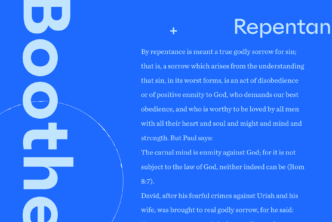Peter Adam explores 20 features of expository preaching—and why he believes it most closely reflects God’s method of verbal revelation—in this excerpt adapted from Theology Is for Preaching: Biblical Foundations, Method, and Practice (just one volume in the Studies in Historical Systematic Theology series).
***
What is expository preaching?
Expository preaching is biblical preaching. It is always the Bible [that] is being expounded, explained, or revealed. It aims to expose what is there, rather than imposing ideas on the Bible passage, using it superficially to serve another agenda or to raise a question, then finding the answer elsewhere than in the Bible.
A broad view of expository preaching includes the exposition of individual texts, passages of the Bible, biblical themes, or biblical characters. Stott claims that the [Bible] “text in question could be a verse, or a sentence, or even a single word.” All of these, when well done, can rightly and usefully expound the Bible in different ways. Here I take a narrower view, that expository preaching expounds books of the Bible because this way of preaching most closely reflects God’s method of verbal revelation.
20 features of expository preaching
1. It recognizes that the units of biblical verbal revelation are the books of the Bible. Expository preaching is sequential preaching, based on sequential reading, the obvious way to read a book!
2. In preaching from a book, it will further the theological and pastoral purpose of the whole book. It takes into account the communicative and persuasive purpose of the book as a whole, and recognizes how each part of the book serves that purpose.
3. It recognizes the historical context of the book, its place in salvation history, in biblical theology, and its canonical context.
4. It recognizes the literary style of the book as a whole and the literary features of the passage to be preached. The length of passage it uses fits the literary style of the chapter or book and the capacity of the congregation.
5. It is shaped by Augustinian, Reformation, and evangelical theology. The expository method by itself may be merely moralistic or superficial, or may be dominated by other sources so that the Bible’s words are marginalized or distorted.
6. It communicates confidence in the power, inspiration, truth, sufficiency, and authority of the Bible and its power to convert, teach, transform, encourage, and mature. God’s power works in the inspired Bible, the preacher, and the hearers.
7. It is shaped by units of meaning rather than verse or chapter numbers.
8. The length of passage to be preached is determined by the style of literature, its theological density, and the capacity of the hearers.
9. It uses a vernacular Bible and vernacular language, if possible.
10. It follows the passage’s purpose, in addressing either God’s people or individuals.
11. It attempts to “project the eloquence of Scripture,” projecting the words, ideas, emotions, relationships, motivations, images, tensions, problems, drama, questions, issues, meaning, and purposes of the passage.
12. It focuses both on God’s book and on God’s people. It pays equal attention to the significance of the passage “to them” as it does “for us.” Though it may be a monologue in style, it will be a dialogue in content, as the preacher engages with, and may articulate, the anticipated responses of the hearers. It takes every opportunity to make connections between passage and hearers, including their current lives in church and world.
13. It takes into account the wide range of people who will hear the sermon, including enquirers, doubters, unbelievers, new Christians, untaught Christians, mature believers, and older Christians who have lost their way.
14. It is theological and practical, intellectual and emotional, serving both the passage and the people.
15. It is designed to be heard, not read, and will communicate, persuade, and invite a specific response.
16. It aims to teach, inform, transform, and train the hearers for ministry and to train and raise up future teachers and preachers of the Bible.
17. It provides a good model for hearers for their own Bible reading, and for how they teach the Bible to others. Sermons which use texts without contexts encourage hearers to treat the Bible the same way.
18. It expresses servant-hearted love for the hearers, for ministry without love is worth nothing and achieves nothing (1 Cor 13:1–3). It is ministry to the people, not performance by the preacher.
19. It expresses the character and experience of the preacher, for sermons are not preached by machines, and God respects his preachers as he respected his Bible writers, each with their own personal style of language and communication.
20. It is soaked in prayer that God would speak his ancient words, and work through them in those who hear, and trusts that God will do what he has promised through his powerful word.
***
Learn more from Adams and find out what he says we can learn from the history of expository preaching from Augustine, Calvin, and others in Theology Is for Preaching.
Or explore these five volumes in the series:
The Federal Theology of Jonathan Edwards: An Exegetical Perspective
“A landmark study in the scholarship of federal theology in general and Edwards scholarship in particular… This is a valuable book for preachers and students of Scripture as well as scholars.” —John Bolt, Emeritus Professor of Systematic Theology, Calvin Theological Seminary
Carl F. H. Henry on the Holy Spirit
“Helping all of us to see our need for the Word of God and the Wind of God, Payne’s volume fills an important role in our interpretation and understanding of this evangelical giant.” —David S. Dockery, Distinguished Professor of Theology, Southwestern Baptist Theological Seminary and President, International Alliance for Christian Education
Hidden and Revealed: The Doctrine of God in the Reformed and Eastern Orthodox Traditions
“This masterfully researched and well-conceived dialogue between Reformed and Orthodox theology enters into core issues: the essence-energies distinction, apophatic theology and human language, analogy and univocity, and divine incomprehensibility and divine revelation… Everyone interested in these issues, whatever their allegiances, will benefit from this lucid and stimulating book.” —Matthew Levering, James N. and Mary D. Perry Jr. Chair of Theology, Mundelein Seminary
Healing the Schism: Karl Barth, Franz Rosenzweig, and the New Jewish-Christian Encounter
“This is the finest piece of theological work yet to emerge from the Messianic Jewish movement . . . she advances to a new level of clarity and rigor the difficult but needed theological conversation on the problems and promise of Messianic Judaism.” —Bruce D. Marshall, Southern Methodist University
In the Name of Our Lord: Four Models of the Relationship Between Baptism, Catechesis, and Communion
“With careful historical and theological precision, Jonathan Watson examines not only the presence of catechesis, baptism, and communion in the life of the churches but also the relationship between them… For scholars and pastors, this volume would be an excellent initiation into this strategic area of ecclesiology.” —Ched Spellman, Associate Professor of Biblical and Theological Studies, Cedarville University; author of Toward a Canon‐Conscious Reading of the Bible
Get Studies in Historical Systematic Theology today.
Related articles
- 8 Principles for Planning Your Preaching Calendar
- What Are the Best Books on Preaching
- My Favorite Example of Engaging the Head & Heart in Preaching
- Pastors, Forget about Creating Tension in Your Sermons. Do This Instead.
- Preparing Sermons with the Workflow Feature






